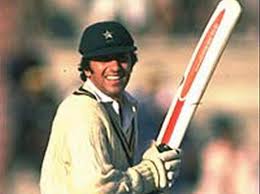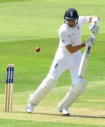When Majid & Zed Almost Stole The Show
Gareth Bland |
Pakistan would finally hit the jackpot and get beyond the semi-final stage of the World Cup at their fourth attempt, in their fifth World Cup appearance in 1992. The emotional roller coaster of Imran Khan’s valedictory tour of Australia that March almost 22 years ago has passed into Pakistani folk legend. Before that, however, there had been three successive attempts to reach the pinnacle. At each stage in 1979, 1983 and 1987 they tried and failed to reach the final. At The Oval in June 1979 they made their first bid with a side containing so many richly gifted individuals that it would have been difficult to make them up had they not existed. Their opposition that day over 34 years ago matched them in their lavish gifts but bested them in discipline. Pakistan’s opponents on 20th June 1979 were Clive Lloyd’s West Indians, the reigning champions. It promised for many reasons to be quite some match up, although the cup holders were favoured to advance to the final at Lord’s.
Each of the combatants had come through their group stages without apparent difficulty. Pakistan had finished runners up to hosts England in Group A, while the West Indians had eased to pole position in Group B ahead of New Zealand, Sri Lanka and India. Up at Headingley Mike Hendrick and the England seamers had reduced Pakistan to 34-6 as they chased a relatively meagre 165, a position from which they never recovered despite the best efforts of Asif Iqbal. In perfect sunlight, on a glorious day in South London, however, conditions promised to be much different than at murky Headingley in the north.
Winning the toss, Asif elected to field. With Imran, Sarfraz, Sikander Bakht and Mudassar Nazar the captain had gambled on seam to see Pakistan through. Majid Khan and Asif would have to contribute and it was hoped that Majid’s heroics with the ball up at Headingley could be replicated in the capital. From the off it looked a forlorn hope as Greenidge and Haynes carved through the Pakistani seamers. Poor Sarfraz, in particular, had a dreadful time, eventually going for 71 in his 12 overs. Majid was economical and Asif finished with 4-56 off 11 overs. Imran ended up three overs short of his full entitlement as the new ball pair had been bludgeoned. Solid batting all the way down meant that West indies finished on 293-6.
The atmosphere had been electric, too. A cacophony of bells, whistles, horns and drums had been beaten out all morning. The resulting exotica of crowd, occasion and glittering assembly of players had left its mark on the young Stephen Moss. Editing the Wisden Anthology: 1978-2006 decades later, Moss remarked that the occasion was:
“the greatest assembly of cricketers I have ever seen in the flesh, and a match to which I got a ticket from a tout at less than face value. Truly, a joyous, unforgettable, buoyantly multicultural experience”
Lest we accuse Moss of wearing his bien pensant heart on his sleeve here, it has to be remarked that the then TCCB’s ruling on banning whistles, horns and drums from grounds in the late 1980s had a particularly antiseptic effect on games which involved the West Indies. Subsequent encounters between the countries on English Test grounds never managed to evoke that same magic, that same open sense of joie de vivre that a generation of cricket followers had been raised on.
When Pakistan went out to bat bells, whistles, horns and the cultural theories of Herbert Marcuse and The Frankfurt School must have been a million miles away from the mind of Sadiq Mohammad, who received a going over from Michael Holding that would have stretched even the capabilities of his elder brother, the great Hanif. At 10-1 with Sadiq dismissed caught Murray, Pakistan were looking down the barrel. It was here that Pakistan showed what a mercurial outfit they could be at their best as Zaheer Abbass walked out to join Majid Khan.
A green helmeted Majid and a blue helmeted Zaheer quickly settled into their groove. At first Majid acted as junior partner as Zaheer picked up the pace. Clean shaven and batting without his usual glasses, Zaheer quickly broke loose and was soon swinging Collis King over deep mid-wicket for six. Amazingly, the pair had added 166 and Pakistan stood at 176-1 needing 118 for victory. It was then that Croft had Zaheer caught behind by Murray for 93. At 187 Majid fell as did Javed Miandad at the same score. Pressure began to mount. Imran, in his autobiography All Round View, observed:
“At one stage we were 176-1, with Majid and Zaheer playing brilliantly. By now the West Indies bowling was looking quite ragged and they were patently nervous. After Zaheer’s dismissal, I felt that Asif should have changed the batting order and not sent in Haroon Rashid, who lacked the sufficient experience of one-day cricket and got bogged down. Haroon wasted valuable overs and put unnecessary pressure on the rest of the batting, and our senior batsmen got out forcing the pace”
And so Pakistan eventually slid to 250 all out as each batsmen attempted to force the pace against the clock. Nine wickets fell for 74 runs as the pace men ratcheted up the pressure while the overs dwindled away. Seeking the escape route of easy runs against Vivian Richards’ off-spin, Asif, Mudassar and Imran all lost their wickets to the Antiguan.
It had been a memorable day for many reasons. The glorious weather, the carnival atmosphere created by the crowd and the finest purveyors of the game in the whole competition out there in the middle. Thirteen years later, against New Zealand at the same semi-final stage, Pakistan would not stumble over their lines this time as they advanced to the final in even more dramatic circumstances. Before then, though, they would have to endure semi-final disappointment twice more, in England, again, to West Indies in 1983, and four years later on home soil against Australia.





Leave a comment